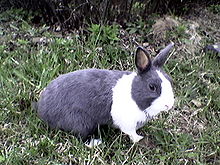Dutch rabbit
The Dutch rabbit is a small breed of rabbit weighing 2.5 to 3.25 kg.
Appearance
The Dutch rabbit is a breed of piebald ( plate or belt spotted ) with very regular, symmetrical patterns. The head drawing consists of the two head plates which, starting from the ears, which are also colored, enclose the nose and the eyes are broad and well rounded around the cheeks to the neck, without running into the tracking hair. The blaze created by the head drawing ends pointedly in front of the ears. The torso drawing includes the rear part of the body as a sharply demarcated ring in the middle of the body, including the structure (in the wild-colored shades only in the lower color). The hind legs are only colored up to about the middle between the ankle and toes, the rest of the foot forms the so-called cuffs. The Dutch rabbit is permitted in all pure colors (not silvered) including the Japanese color.
Genetically, the drawing of the Dutch rabbit is based on the so-called plate or belt check . The corresponding mutation has the effect that during embryonic development in the neural crest, due to superficial defects, the formation of melanoblasts does not occur to varying degrees, which otherwise, following the blood vessels, migrate into the skin surfaces and thus into the hair roots and there, as melanocytes, carry out pigment formation.
In the hereditary formula, this factor is represented by S (not spotted) or s (1 ... 3 ...) (in international symbolism by Du (from Dutch = Dutch)) for non-spotted and dud (dark) and duw ( light) for the different extent of the check. It should be noted that the numbering of the plate check factors does not correspond to individual, cumulative genes, but corresponds to different mutation levels of the factor.
History of the breed
Rabbits with the drawing of today's Dutch rabbits have been known for several centuries. Representations of such rabbits can be found on historical paintings; Among the oldest are the picture "Ferrets and Rabbits" by Hänßlein von Hagenau (1401) and "Adoration of the Holy Child" by Turro (1450). In the continental cycle of the painter Jan van Kessel (around 1660) there is also a Dutch rabbit drawn almost in accordance with the standard. The Brabant rabbits, which are widely bred in the present-day Netherlands and Belgium and exported to Great Britain as slaughter animals, also showed the plate check to varying degrees. The breed was bred to the form common today from such Brabant rabbits in Great Britain , from where the Dutch rabbit then returned to the continent. Joppich describes that the first animals imported from England to Germany had a little less markings than those known today (narrower blaze, ring pulled further forward). According to Joppich, the Dutch rabbits came to Germany in the early 1880s; They were first presented at exhibitions in Chemnitz in 1891 and described in the standard from 1898. Since then, they have been bred in an almost unchanged form, albeit with an increasing number of colors.
Similar races
In their drawing, the Dutch rabbits are unique among rabbit breeds. Similar plate checks can also be found in other domestic animals, so house guinea pigs are very often seen with a drawing similar to the Dutch rabbit.
Due to its distinctive drawing, the Dutch rabbit is the "heraldic animal" of numerous rabbit breeding associations and associations, appropriately also that of the Dutch Rabbit Breeders Association.
literature
- A. Franke: Holländerkaninchen , in: The small animal breeder - Rabbit 5/1998 ISSN 0941-0848
- G. Hochstrasser: Plattenscheckung and Dutch factor (s) , in: The small animal breeder - Rabbit 5/1999 ISSN 0941-0848
- G. Hochstrasser: Domestic rabbits in old pictures , in: The small animal breeder - rabbits 4/2000 ISSN 0941-0848
- G. Hochstrasser: "Japanese" existed in Amsterdam as early as 1660 , in: The small animal breeder - rabbits 4/2000 ISSN 0941-0848
- G. Hochstrasser: The x-factor and the s-factors are part of the same s-series, the neural crest defect series! , in: The Blue Yearbook 2002 - A Practical Guide to the Rabbit Breeder, Oertel and Spörer, Reutlingen, 2002, pages 308–326.
- G. Hochstrasser: Japanese colored rabbits around 1660 - or is it? , in: Der Kleintierzüchter - Rabbit 13/2006 ISSN 1613-6357
- Friedrich Joppich: The rabbit , Berlin, VEB Deutscher Landwirtschaftsverlag, 1967
- John C. Sandford: The domestic rabbit , 5 th edition, Blackwell Science, Oxford 1996 ISBN 0-632-03894-2
- Wolfgang Schlolaut: The big book of the rabbit , 2nd edition, DLG-Verlag, Frankfurt 1998 ISBN 3-7690-0554-6

